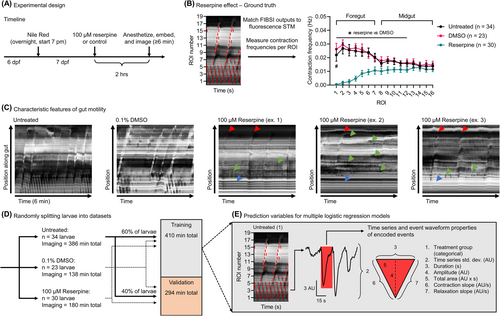Fig. 2
- ID
- ZDB-FIG-240222-37
- Publication
- Cassidy et al., 2023 - Systematic analysis of proximal midgut- and anorectal-originating contractions in larval zebrafish using event feature detection and supervised machine learning algorithms
- Other Figures
- All Figure Page
- Back to All Figure Page
|
Experimental design for testing reserpine effect on gut motility and datasets used to train and validate multiple logistic regression models. (A) Experimental timeline. (B) Left: Example fluorescence STM and superimposed matched events detected by FIBSI (red ticks). Right: Contraction frequencies measured per ROI (ground truth). Results represent the mean ± 95% CI. Refer to Table 2 for ANOVA and post hoc test results. *p < 0.05 for reserpine versus DMSO comparisons, #p < 0.05 for untreated versus DMSO comparisons. (C) Example fluorescence STMs. Absence of pRCs (blue arrows), absence of contraction-mediated dye transit (red arrows), and increased occurrence of non-propagating contractions (green arrows, green box at first arrow) labeled in STMs of reserpine-treated larvae. (D) Random sorting of larvae by group into training (60%) and validation (40%) datasets. (E) Outputs of FIBSI for each event in the training dataset used as prediction variables for multiple logistic regression models. |

